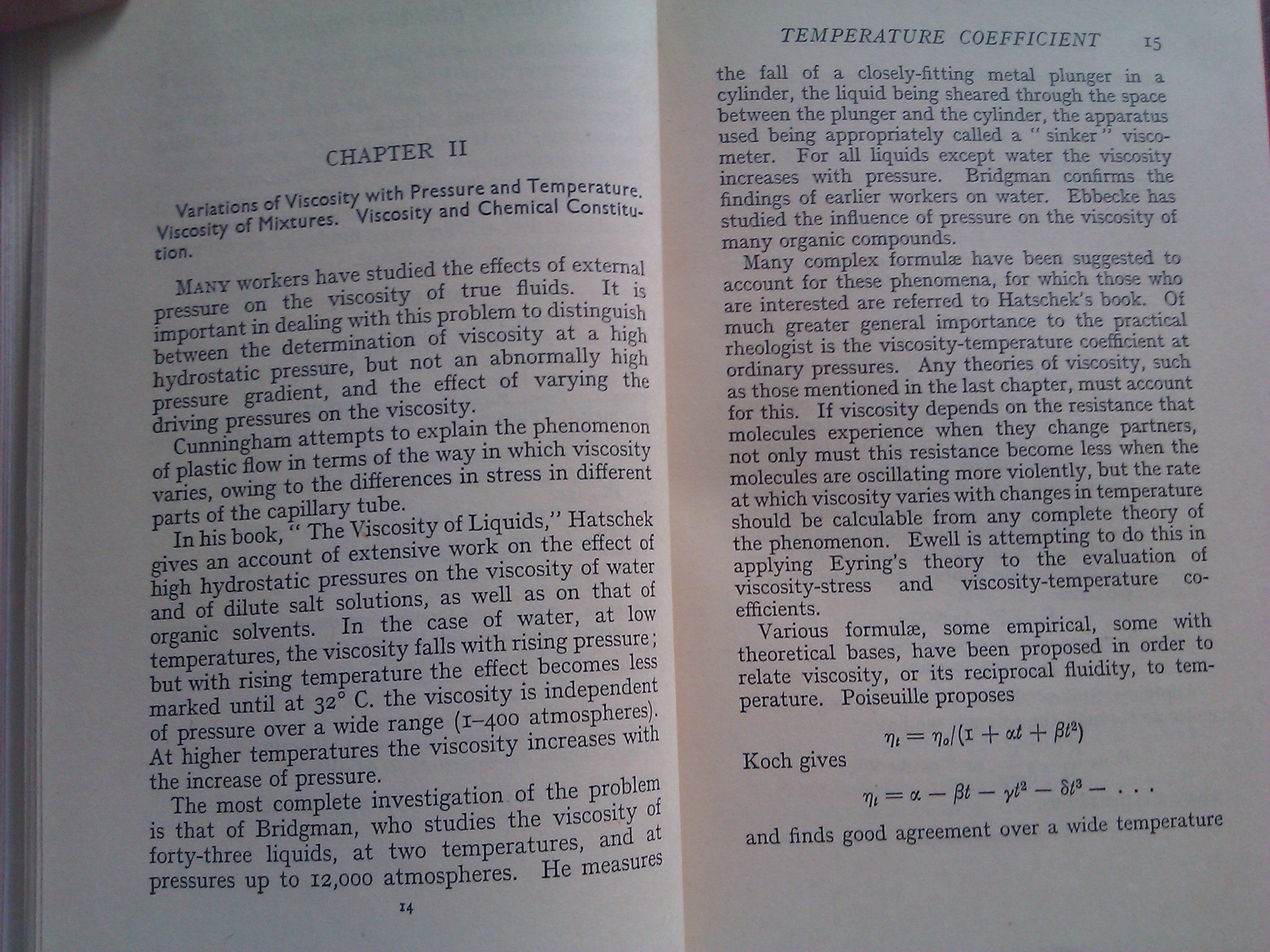str (133)

CHAPTER II
Yariarions of Viscosity with Pressure and Temperaturę. Yiscosity of Mixtures. Viscosity and Chemical Constitu-tion.
Many workers have studied the effects of extemal pressure on the viscosity of true fłuids. It is important in dealing with this problem to distinguish between the determination of yiscosity at a high hydrostatic pressure, but not an abnormally high pressure gradient, and the effect of yaiying the driving pressures on the yiscosity.
Cunningham attempts to explain the phenomenon of plastic flow in terms of the way in włnch yiscosity yaries, owing to the differences in stress in different parts of the capillary tubę.
In his book, * The yiscosity of Liąuids/' Hatschek I gives an account of extensive work on the effect of high hydrostatic pressures on the yiscosity of water I and of dilute salt Solutions, as well as on that of I organie solvents. In the case bf water, ffl Iow I temperatures, the yiscosity falls with riśing pressure; I but with rising temperaturę the effect becomes less I marked until at 32 ° C. the yiscosity. is independent I of pressure over a wide rangę (1-400 afanospheres). I At higher temperatures the yiscosity inereases with I the inerease bf pressure.
The most complete inyestigation .of the problem fl is that of Bridgman, who studies the ffgcosijty of H forty-three liąuids, at two temperatures, and at H pressures up to 12,000 atmospheres. He measures H
TEMPERATURĘ COEFFICIENT
15
the fali of a closely-fitting metal plunger in a cylinder, the liquid being sheared through the space between the plunger and the cylinder, the apparatus used being appropriately called a “ sinker ' visco-meter. For all liąuids except water the yiscosity inereases with pressure. Bridgman confirms the findings of earlier workers on water. Ebbecke has studied the influence of pressure on the yiscosity of many organie compounds.
Many complex formulae have been suggested to account for these phenomena, for which those who are interested are referred to Hatschek's book. Of much greater generał importance to the practical rheologist is the yiscosity-temperature coefficient at ordinary pressures. Any theories of yiscosity, such as those mentioned in the last chapter, must account for this. If yiscosity depends on the resistance that molecules experience when they change partners, not only must this resistance become less when the molecules are oscillating morę yiolently, but the ratę at which yiscosity yaries with changes in temperaturę should be calculable from any complete theory of the phenomenon. Ewell is attempting to do this in applying Eyring's theory to the eyaluation of yiscosity-stress and yiscosity-temperature c0-
efficients.
Various formulse, some empirical, some with theoretical bases, have been proposed in order to relate yiscosity, or its reciprocal fluidity, to temperature. Poiseuille proposes
I I m — W(* + o* + A
Koch gives
7j( — 01 — f3t — yt3 — Sta — , . . and finds good agreement over a wide temperaturę
Wyszukiwarka
Podobne podstrony:
Chapter II - ORGANIZATION 1. Factual information Name of the establishments: Wrocław Universitv of
Special TechniąuesMaking Cables With-out a Cable Needle CrosMng ?titches with a cable needle takes i
CHAPTER II 17 86230 the econoay by public spending, whlch has not at the beglnnlng of a period a cor
CHAPTER II 18 86230 Inflatlonary praisurts In the occurrence of expanslve spells. This good lenie1
mbs 032 CHAPTER II. THE MACHINERY OF THE BREATHING APPARATUS. A ruLL explanation of the anatomy of t
A LOOK OVERSEAS / ROZDZIAŁ: THE OUTBREAK OF WORLD WAR II 1939POLES ACCEPT WAR WITH GREAT CALM End of
59735 str (119) CHAPTER V Concentric Cylinder Vlscometers. The Elastic Pro. perties of Sols. Flow-el
FIGURĘ 6.22 Binding of RNA Polymerase II to Promoter Starting with TFIID, wbich conłains TATA b
więcej podobnych podstron